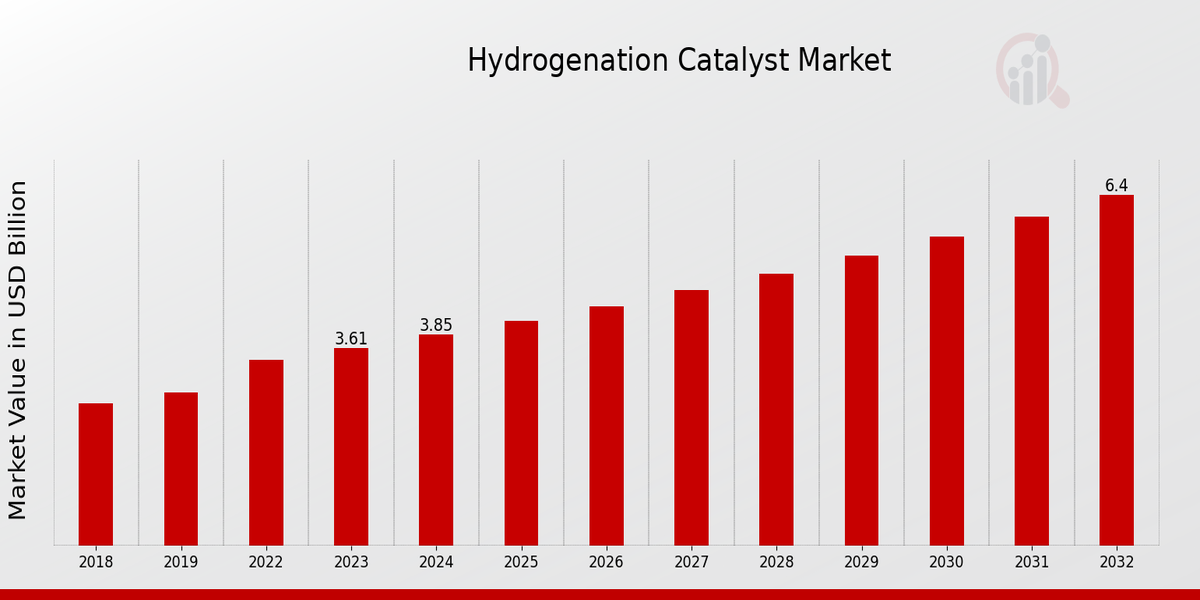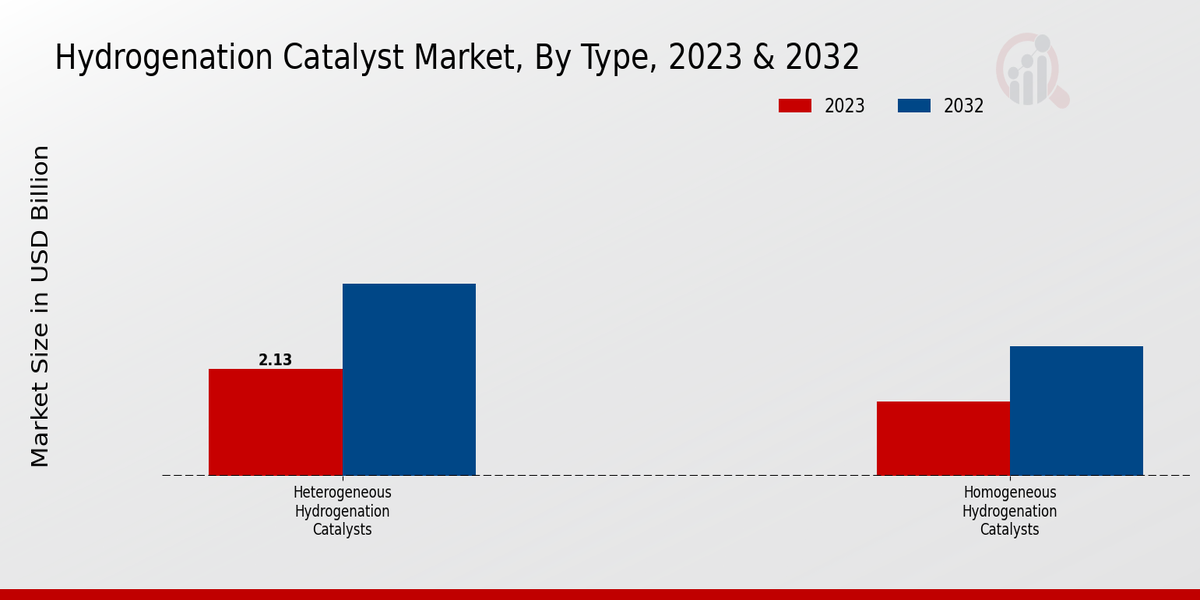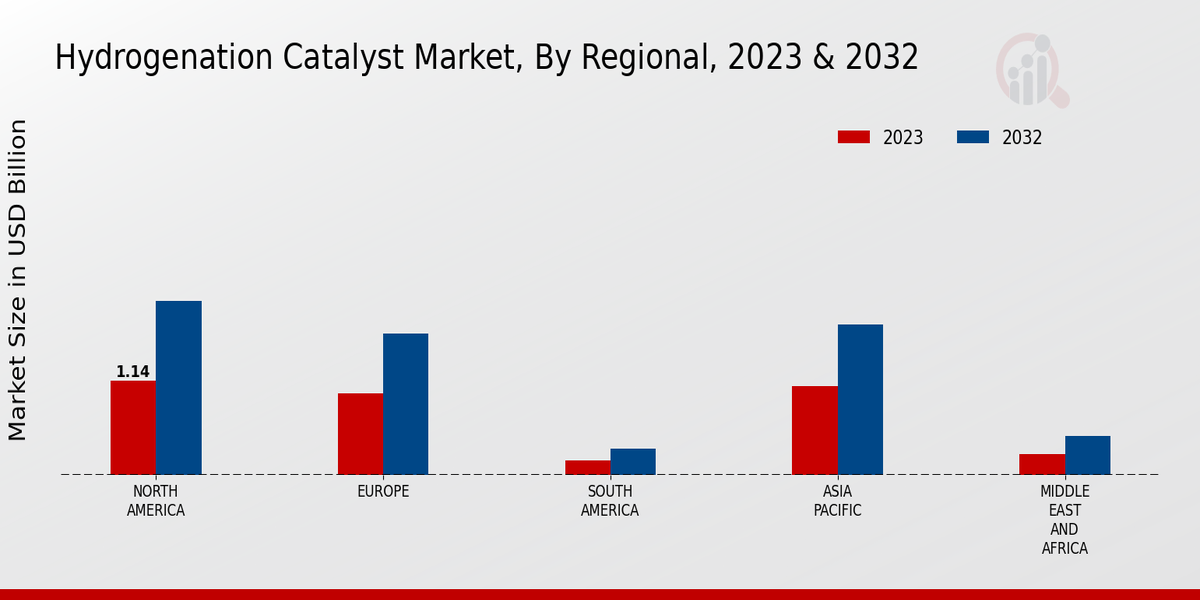Global Hydrogenation Catalyst Market Overview
The Hydrogenation Catalyst Market Size was estimated at 3.39 (USD Billion) in 2022. The Hydrogenation Catalyst Industry is expected to grow from 3.61(USD Billion) in 2023 to 6.4 (USD Billion) by 2032. The Hydrogenation Catalyst Market CAGR (growth rate) is expected to be around 6.57% during the forecast period (2024 - 2032).
Key Hydrogenation Catalyst Market Trends Highlighted
The global Hydrogenation Catalyst Market is experiencing significant growth, driven by increasing demand for hydrogenated oils and fats in the food industry. Hydrogenation catalysts facilitate the conversion of vegetable oils into saturated fats, which have improved stability, longer shelf life, and higher melting points. This demand is expected to remain strong in the coming years, as hydrogenated fats are extensively used in margarine, shortening, and packaged food products. Furthermore, the growing adoption of hydrogenation catalysts in the chemical and pharmaceutical industries presents opportunities for market growth. Hydrogenation is widely employed in the production of fine chemicals, pharmaceuticals, and polymers, enabling the addition of hydrogen molecules to unsaturated compounds. This process enhances their chemical properties and stability, leading to increased demand for hydrogenation catalysts in these sectors.
Recent trends indicate a shift towards sustainable and eco-friendly hydrogenation catalysts. Market participants are focusing on developing catalysts that operate efficiently in milder conditions, reducing energy consumption and environmental impact. Additionally, advancements in catalyst design have led to improved activity and selectivity, resulting in higher hydrogenation efficiency and reduced waste generation. These advancements contribute to the growing adoption of hydrogenation catalysts in various industries, driving the market's continued expansion.

Source: Primary Research, Secondary Research, MRFR Database and Analyst Review
Hydrogenation Catalyst Market Drivers
Growing Demand for Hydrogenated Oils and Fats in the Food and Beverage Industry
Hydrogenation is a chemical process that involves the addition of hydrogen to unsaturated fats and oils, resulting in the formation of saturated fats. Saturated fats have a higher melting point and are more stable than unsaturated fats, which makes them ideal for use in a variety of food and beverage applications. The growing demand for hydrogenated oils and fats in the food and beverage industry is a major driver of the global hydrogenation catalyst market. Hydrogenated oils and fats are used in a wide range of food products, including margarine, shortening, and cooking oils. They are also used in the production of baked goods, confectionery, and other processed foods. The increasing consumption of processed foods, coupled with the rising population and urbanization, is expected to drive the demand for hydrogenated oils and fats in the coming years.
Stringent Environmental Regulations and Focus on Sustainability
Stringent environmental regulations and a focus on sustainability are also driving the growth of the global hydrogenation catalyst market. Catalysts are vital components of the hydrogenation process because they reduce the negative effects of the latter on the environment. Catalysts are materials that increase the efficiency of the hydrogenation process and reduce the formation of harmful by-products. In addition, the increased concern for environmental preservation and the greater application of sustainability principles in food and beverage has enhanced the demand for environmentally friendly hydrogenation catalysts that utilize energy efficiently.
Technological Advancements and Innovations
Furthermore, technological advancements coupled with innovation are a major factor propelling the growth of the market for hydrogenation catalysts in a global scenario. For instance, the increasing infiltration of new hydrogenation catalysts is efficient, productive, and has better selectivity and leads to wide-ranging applications. Additionally, the ongoing research development in the technology is expected to drive the growth of the market in the near future.
Hydrogenation Catalyst Market Segment Insights
Hydrogenation Catalyst Market Type Insights
The Hydrogenation Catalyst Market Segmentation by Type includes Heterogeneous Hydrogenation Catalysts and Homogeneous Hydrogenation Catalysts. Heterogeneous Hydrogenation Catalysts held a larger market share in the Hydrogenation Catalyst Market in 2023, and it is projected to continue its dominance over the forecast period. Heterogeneous hydrogenation catalysts are preferred in various industrial applications owing to their high activity, selectivity, and stability. The major types of heterogeneous hydrogenation catalysts include supported metal catalysts, metal oxide catalysts, and carbon-based catalysts. Supported metal catalysts, such as nickel on alumina, are widely used in the hydrogenation of vegetable oils, fats, and pharmaceuticals. Metal oxide catalysts, like copper oxide and zinc oxide, find applications in the hydrogenation of alkenes and alkynes. Carbon-based catalysts, such as activated carbon and carbon nanotubes, are gaining attention from various industries owing to their ability to hydrogenate complex molecules and resistance to deactivation. Homogeneous Hydrogenation Catalysts are expected to witness a promising CAGR during the forecast period.Homogeneous hydrogenation catalysts are used in the production of fine chemicals and pharmaceuticals, as they offer high selectivity and regiospecificity. The major types of homogeneous hydrogenation catalysts include metallocene catalysts, transition metal complexes, and organocatalysts. Metallocene catalysts, such as ferrocene and titanocene, are used in the hydrogenation of alkenes and alkynes. Transition metal complexes, such as Wilkinson’s catalyst and Grubbs’ catalyst, are used in various organic synthesis reactions. Organocatalysts, such as proline and amino acids, are used to promote asymmetric hydrogenation reactions. The increasing demand for fine chemicals and pharmaceuticals is expected to drive the growth of the homogeneous hydrogenation catalyst segment.

Source: Primary Research, Secondary Research, MRFR Database and Analyst Review
Hydrogenation Catalyst Market Application Insights
The application segment plays a pivotal role in shaping the Hydrogenation Catalyst Market. Among the key application areas, petroleum refining holds the largest market share, accounting for approximately 35% of the global revenue in 2023. This dominance is driven by the extensive use of hydrogenation catalysts in the refining process to remove impurities and improve fuel quality. Chemical manufacturing is another significant application segment, with a market share of around 28%. Hydrogenation catalysts facilitate various chemical reactions, including the production of polymers, solvents, and intermediates.The food and beverage industry holds a notable market share of 20%, as hydrogenation catalysts are employed in the processing of fats and oils to enhance their stability and shelf life. Furthermore, the pharmaceuticals sector accounts for 12% of the market, leveraging hydrogenation catalysts in the synthesis of active pharmaceutical ingredients (APIs). The remaining 5% of the market is attributed to other applications, including the production of cosmetics, fragrances, and fine chemicals.
Hydrogenation Catalyst Market End Use Insights
The End Use segment is a crucial aspect of the Hydrogenation Catalyst Market segmentation, offering valuable insights into the market dynamics and growth potential of different end-use industries. The market is primarily driven by the demand for hydrogenation catalysts in various end-use applications, including Liquid Fuels, Gases and Petrochemicals. Liquid Fuels hold a significant share of the market due to the extensive use of hydrogenation catalysts in the refining processes of crude oil and other feedstocks to produce high-quality fuels such as gasoline, diesel, and jet fuel. The growing demand for cleaner and more efficient fuels is driving the growth of this segment. Gases, including hydrogen and ammonia, represent another major end-use segment. Hydrogenation catalysts play a vital role in the production of hydrogen via steam reforming of natural gas and other processes. The rising demand for hydrogen as a clean energy source and its use in fuel cells is expected to fuel the growth of this segment. Petrochemicals is another key end-use industry for hydrogenation catalysts. These catalysts are employed in various processes, including the production of olefins, aromatics, and other petrochemical intermediates.The growing demand for petrochemicals in industries such as plastics, packaging, and automotive is driving the growth of this segment. Overall, the End Use segment provides insights into the specific applications and industries that drive the demand for hydrogenation catalysts, enabling market participants to identify growth opportunities and target specific end-use markets for product development and marketing strategies.
Hydrogenation Catalyst Market Product Form Insights
The Hydrogenation Catalyst Market Segmentation by Product Form comprises Supported Catalysts, Unsupported Catalysts and Catalysts on Carbon Nanotubes. Supported Catalysts dominate the market with over 60% of the Hydrogenation Catalyst Market revenue in 2023, owing to their high efficiency, selectivity, and ability to handle a wide range of substrates. Unsupported Catalysts are projected to witness the fastest growth during the forecast period, driven by their cost-effectiveness and ease of handling. Catalysts on Carbon Nanotubes, although a relatively niche segment, offer unique advantages such as enhanced activity and stability, making them attractive for specialized applications.
Hydrogenation Catalyst Market Regional Insights
The Hydrogenation Catalyst Market is segmented into North America, Europe, APAC, South America and MEA. Among these regions, North America is expected to hold the largest market share in 2023, with a valuation of 1.25 Billion USD. The growth in this region is attributed to the increasing demand for hydrogenated products in various industries, such as food, pharmaceuticals and chemicals. Europe is expected to be the second largest market, with a valuation of 1.08 Billion USD in 2023. The growth in this region is attributed to the stringent environmental regulations and the rising demand for renewable energy sources.APAC is expected to be the fastest-growing region, with a CAGR of 7.2% during the forecast period. The growth in this region is attributed to the increasing industrialization and the growing population. South America and MEA are expected to have a relatively smaller market share, but they are expected to witness steady growth during the forecast period.

Source: Primary Research, Secondary Research, MRFR Database and Analyst Review
Hydrogenation Catalyst Market Key Players And Competitive Insights:
Major players in Hydrogenation Catalyst Market industry are continuously investing in research and development to improve the efficiency and selectivity of their catalysts. Leading Hydrogenation Catalyst Market players are also focusing on developing new catalysts that can be used in a wider range of applications. The Hydrogenation Catalyst Market competitive landscape is expected to remain competitive in the coming years, with new entrants and established players vying for market share.BASF is a leading global supplier of hydrogenation catalysts. The company's catalysts are used in a variety of applications, including the production of chemicals, pharmaceuticals and food ingredients. BASF is committed to innovation and is continuously developing new catalysts to meet the evolving needs of its customers. The company's strong financial position and global reach give it a competitive advantage in the Hydrogenation Catalyst Market.Honeywell is a leading global supplier of hydrogenation catalysts. The company's catalysts are used in a variety of applications, including the production of chemicals, pharmaceuticals and food ingredients. Honeywell is committed to innovation and is continuously developing new catalysts to meet the evolving needs of its customers. The company's strong financial position and global reach give it a competitive advantage in the Hydrogenation Catalyst Market.
Key Companies in the Hydrogenation Catalyst Market Include
- LyondellBasell
- Evonik Industries
- Clariant
- Asahi Kasei Corporation
- BASF SE
- Teck Resources
- JX Nippon Mining Metals
- Dow Inc.
- Haldor Topsoe
- Umicore
- Johnson Matthey
- Royal Dutch Shell
- R. Grace Co.
- Brenntag
- SudChemie
Hydrogenation Catalyst Market Industry Developments
The global hydrogenation catalyst market is projected to reach USD 6.4 billion by 2032, exhibiting a CAGR of 6.57% during the forecast period (2024-2032). Increasing demand for hydrogenated oils and fats in the food, pharmaceutical, and cosmetic industries is driving market growth. Government initiatives promoting the use of biofuels and rising environmental concerns about greenhouse gas emissions are further fueling demand for hydrogenation catalysts. Key industry participants include BASF, Albemarle, Clariant, and Johnson Matthey, who are focusing on enhancing catalyst efficiency and selectivity. Recent advancements in nanotechnology and the development of supported metal catalysts are expected to create new growth opportunities in the market.
Hydrogenation Catalyst Market Segmentation Insights
Hydrogenation Catalyst Market Type Outlook
- Heterogeneous Hydrogenation Catalysts
- Homogeneous Hydrogenation Catalysts
Hydrogenation Catalyst Market Application Outlook
- Petroleum Refining
- Chemical Manufacturing
- Food and Beverage Industry
- Pharmaceuticals
- Others
Hydrogenation Catalyst Market End Use Outlook
- Liquid Fuels
- Gases
- Petrochemicals
Hydrogenation Catalyst Market Product Form Outlook
- Supported Catalysts
- Unsupported Catalysts
- Catalysts on Carbon Nanotubes
Hydrogenation Catalyst Market Regional Outlook
- North America
- Europe
- South America
- Asia Pacific
- Middle East and Africa
| Report Attribute/Metric |
Details |
| Market Size 2022 |
3.39(USD Billion) |
| Market Size 2023 |
3.61(USD Billion) |
| Market Size 2032 |
6.4(USD Billion) |
| Compound Annual Growth Rate (CAGR) |
6.57% (2024 - 2032) |
| Report Coverage |
Revenue Forecast, Competitive Landscape, Growth Factors, and Trends |
| Base Year |
2023 |
| Market Forecast Period |
2024 - 2032 |
| Historical Data |
2019 - 2023 |
| Market Forecast Units |
USD Billion |
| Key Companies Profiled |
LyondellBasell, Evonik Industries, Clariant, Asahi Kasei Corporation, BASF SE, Teck Resources, JX Nippon Mining Metals, Dow Inc., Haldor Topsoe, Umicore, Johnson Matthey, Royal Dutch Shell, W. R. Grace Co., Brenntag, SudChemie |
| Segments Covered |
Type, Application, End Use, Product Form, Regional |
| Key Market Opportunities |
1. Growing demand for refined fuels 2. Rising investment in biofuel production 3. Increasing adoption in chemical synthesis 4. Expanding pharmaceutical industry 5. Technological advancements in hydrogenation processes |
| Key Market Dynamics |
1. Increasing demand for biofuels 2. Growing pharmaceutical industry 3. Advancements in nanotechnology 4. Government initiatives and regulations 5. Stringent environmental regulations |
| Countries Covered |
North America, Europe, APAC, South America, MEA |
Frequently Asked Questions (FAQ) :
The global Hydrogenation Catalyst Market was valued at 3.61 Billion USD in 2023 and is projected to reach 6.4 Billion USD by 2032, exhibiting a CAGR of 6.57% during the forecast period (2024 - 2032).
Asia-Pacific is projected to account for the largest market share, owing to the increasing demand for hydrogenated oils and fats in the region.
The food industry is anticipated to register the highest growth rate due to the growing demand for hydrogenated oils and fats in food products.
Some of the key competitors operating in the global Hydrogenation Catalyst Market include BASF, Clariant, Albemarle, Evonik, and Johnson Matthey.
The major factors driving the growth of the Hydrogenation Catalyst Market are the increasing demand for hydrogenated oils and fats, the rising consumption of processed foods, and the growing population.
The major challenges faced by the Hydrogenation Catalyst Market include the stringent regulations regarding the use of hydrogenated oils and fats, the availability of substitutes, and the fluctuating prices of raw materials.
Some of the key trends observed in the Hydrogenation Catalyst Market include the development of new and more efficient catalysts, the increasing adoption of sustainable practices, and the growing demand for customized catalysts.
The COVID-19 pandemic had a significant impact on the Hydrogenation Catalyst Market, leading to a decline in demand for hydrogenated oils and fats. However, the market is expected to recover in the post-pandemic period.
The future outlook of the Hydrogenation Catalyst Market is positive, with the market expected to grow at a steady pace over the next decade.
The key growth opportunities for the Hydrogenation Catalyst Market include the increasing demand for hydrogenated oils and fats in emerging markets, the development of new and more efficient catalysts, and the growing adoption of sustainable practices.

















